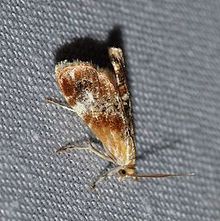| Dicymolomia julianalis | |
|---|---|

| |
|
Scientific classification
| |
| Domain: | Eukaryota |
| Kingdom: | Animalia |
| Phylum: | Arthropoda |
| Class: | Insecta |
| Order: | Lepidoptera |
| Family: | Crambidae |
| Genus: | Dicymolomia |
| Species: | D. julianalis
|
| Binomial name | |
| Dicymolomia julianalis | |
| Synonyms | |
| |
Dicymolomia julianalis, or Julia's dicymolomia moth, is a moth of the family Crambidae. It is found in most of eastern North America [2] and on Cuba.
Diet
The larvae have a diverse diet and have been recorded feeding on Astragalus canadensis and Cirsium lecontei. They have also been recorded as internal feeders in cattails ( Typha species) and cactus stems ( Opuntia species). Furthermore, they feed on senescent cotton bolls ( Gossypium species) and are also known as predators on the eggs and larvae of Thyridopteryx ephemeraeformis. [3]
References
- ^ Nuss, M.; et al. (2003–2017). "GlobIZ search". Global Information System on Pyraloidea. Retrieved January 4, 2018.
- ^ Moth Photographers Group. Mississippi State University.
- ^ Biology and description of the larva of Dicymolomia metalliferalis: A casebearing Glaphyriine (Pyralidae)
| Dicymolomia julianalis | |
|---|---|

| |
|
Scientific classification
| |
| Domain: | Eukaryota |
| Kingdom: | Animalia |
| Phylum: | Arthropoda |
| Class: | Insecta |
| Order: | Lepidoptera |
| Family: | Crambidae |
| Genus: | Dicymolomia |
| Species: | D. julianalis
|
| Binomial name | |
| Dicymolomia julianalis | |
| Synonyms | |
| |
Dicymolomia julianalis, or Julia's dicymolomia moth, is a moth of the family Crambidae. It is found in most of eastern North America [2] and on Cuba.
Diet
The larvae have a diverse diet and have been recorded feeding on Astragalus canadensis and Cirsium lecontei. They have also been recorded as internal feeders in cattails ( Typha species) and cactus stems ( Opuntia species). Furthermore, they feed on senescent cotton bolls ( Gossypium species) and are also known as predators on the eggs and larvae of Thyridopteryx ephemeraeformis. [3]
References
- ^ Nuss, M.; et al. (2003–2017). "GlobIZ search". Global Information System on Pyraloidea. Retrieved January 4, 2018.
- ^ Moth Photographers Group. Mississippi State University.
- ^ Biology and description of the larva of Dicymolomia metalliferalis: A casebearing Glaphyriine (Pyralidae)